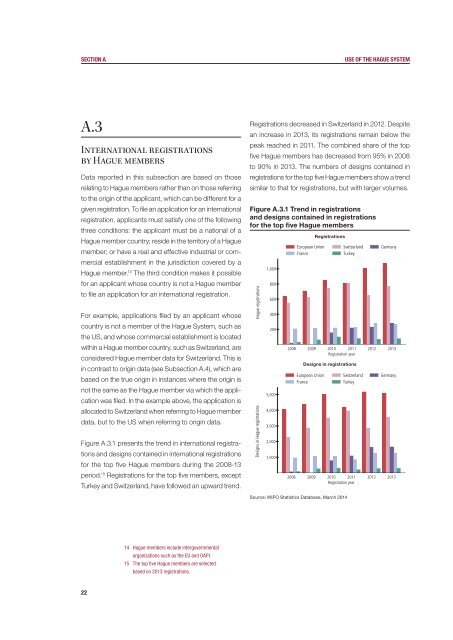wEyG1
wEyG1
wEyG1
You also want an ePaper? Increase the reach of your titles
YUMPU automatically turns print PDFs into web optimized ePapers that Google loves.
SECTION A<br />
USE OF THE HAGUE SYSTEM<br />
A.3<br />
International registrations<br />
by Hague members<br />
Data reported in this subsection are based on those<br />
relating to Hague members rather than on those referring<br />
to the origin of the applicant, which can be different for a<br />
given registration. To file an application for an international<br />
registration, applicants must satisfy one of the following<br />
three conditions: the applicant must be a national of a<br />
Hague member country; reside in the territory of a Hague<br />
member; or have a real and effective industrial or commercial<br />
establishment in the jurisdiction covered by a<br />
Hague member. 14 The third condition makes it possible<br />
for an applicant whose country is not a Hague member<br />
to file an application for an international registration.<br />
For example, applications filed by an applicant whose<br />
country is not a member of the Hague System, such as<br />
the US, and whose commercial establishment is located<br />
within a Hague member country, such as Switzerland, are<br />
considered Hague member data for Switzerland. This is<br />
in contrast to origin data (see Subsection A.4), which are<br />
based on the true origin in instances where the origin is<br />
not the same as the Hague member via which the application<br />
was filed. In the example above, the application is<br />
allocated to Switzerland when referring to Hague member<br />
data, but to the US when referring to origin data.<br />
Figure A.3.1 presents the trend in international registrations<br />
and designs contained in international registrations<br />
for the top five Hague members during the 2008-13<br />
period. 15 Registrations for the top five members, except<br />
Turkey and Switzerland, have followed an upward trend.<br />
Registrations decreased in Switzerland in 2012. Despite<br />
an increase in 2013, its registrations remain below the<br />
peak reached in 2011. The combined share of the top<br />
five Hague members has decreased from 95% in 2008<br />
to 90% in 2013. The numbers of designs contained in<br />
registrations for the top five Hague members show a trend<br />
similar to that for registrations, but with larger volumes.<br />
Figure A.3.1 Trend in registrations<br />
and designs contained in registrations<br />
for the top five Hague members<br />
Hague registrations<br />
Designs in Hague registrations<br />
1,000<br />
800<br />
600<br />
400<br />
200<br />
5,000<br />
4,000<br />
3,000<br />
2,000<br />
1,000<br />
Registrations<br />
European Union Switzerland Germany<br />
France<br />
Turkey<br />
2008 2009 2010 2011 2012 2013<br />
Registration year<br />
Designs in registrations<br />
European Union Switzerland Germany<br />
France<br />
Turkey<br />
2008 2009 2010 2011 2012 2013<br />
Registration year<br />
Source: WIPO Statistics Database, March 2014<br />
14 Hague members include intergovernmental<br />
organizations such as the EU and OAPI.<br />
15 The top five Hague members are selected<br />
based on 2013 registrations.<br />
22


